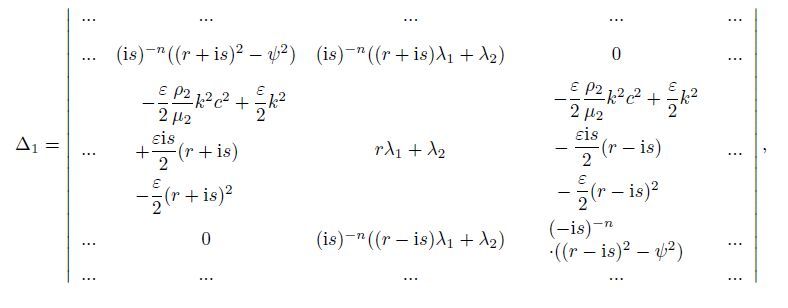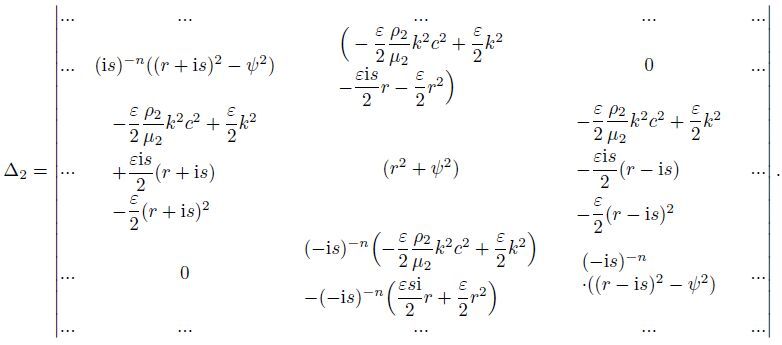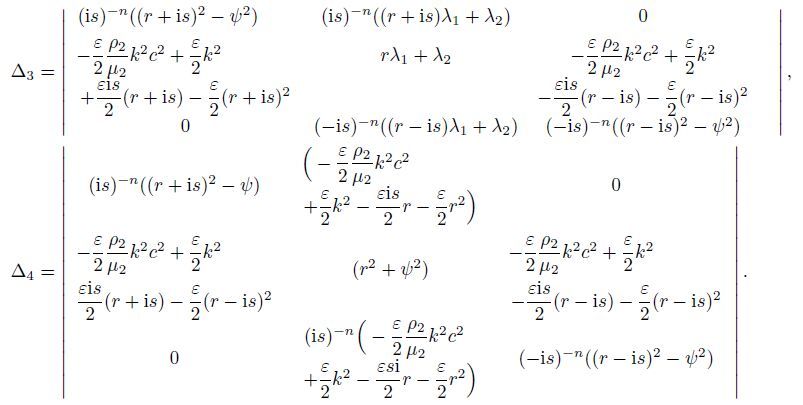Shanghai University
Article Information
- S. K. VISHWAKARMA, Runzhang XU. 2016.
- G-type dispersion equation under suppressed rigid boundary:analytic approach
- Appl. Math. Mech. -Engl. Ed., 37(4): 501-512
- http://dx.doi.org/10.1007/s10483-016-2048-9
Article History
- Received Jan. 12, 2015;
- in final form Oct. 28, 2015
2. Department of Mathematics, Birla Institute of Technology and Science(BITS), Pilani, Hyderabad Campus, Hyderabad 500078, India;
3. College of Science, Harbin Engineering University, Harbin 150001, China
The existence of a low velocity layer in the half-space of the Earth was established by Gutenberg[1, 2]. He discovered that there exists a wave that is nothing but horizontally polarized surface waves of shear type or a Love type wave of long periods (60 s-300 s). Thus,the wave was named as the G-type seismic wave. Long chains of waves dispersed with large amplitudes were observed on Seismograms of distant surface earthquakes,and this dispersion is easily caught as first arrivals corresponding to the waves of longer periods. For these long period waves like G-type,the dispersion curve is practically flat with a velocity of 4.4 km/s and has an almost impulsive form[3, 4, 5, 6],because the Love wave has a constant phase velocity of 4.4 km/s over a period of 40 s to 300 s,and their waveform is rather impulsive. We can better think of G-type with the period of 60 s-300 s. After a devastating earthquake,a chain of G-waves can be observed as it takes about two and a half hours for G-waves to travel round the globe. The long period waves mainly propagate through mantle. Thus,they are also known as mantle waves.
Experimental and theoretical investigation aiming to gain a better understanding of the real Earth has led to a requirement for more practical representation of various media through which seismic waves propagate. Therefore,in the present paper,a better realistic approach is considered by assuming a rigid boundary plane on the Earth’s crustal layer. The dispersion of seismic waves is highly affected by the elastic properties of the substratum’s materials. Moreover, the composition of the layers might be inhomogeneous and isotropic in nature or may be orthotropic,monoclinic,or any other anisotropic medium. The dispersion equation of the phase and the group velocity of the surface wave thus relies on the characteristics of the medium. Thus, these studies allow the estimate of the structure along their trajectories. Many scientists have given their immense contribution in the study of shear wave dispersion in an elastic medium by taking constant or variable velocity,rigidity,and density into account. Aki[7] worked on Niigata earthquake and explained the generation and propagation of G-waves,while Chattopadhyay[8] demonstrated the generation of G-type seismic waves. Chattopadhyay and Keshri[9] explained the impact of initial stress on G-type seismic waves. Recently,Chattopadhyay and Singh[10] worked on reinforced media and explained the propagation characteristic of G-type wave in such a medium. Yoshida[11] explained how a dent across the continental crust contributes in the fluctuation of the group velocity of Love waves. Manna et al.[12] studied propagation of Love wave in a piezoelectric layer over an inhomogeneous elastic half-space,whereas Singh[13] studied the influence of Love wave in irregular boundary surfaces. Recently,Lei et al.[14] described theoretically shear horizontal (SH) wave propagation in the periodically-layered piezomagnetic structure. The possibility of Love wave dispersion under the condition of linearly varying porosity and rigidity was investigated by Gupta et al.[15]. Gupta and Vishwakarma[16] explained remarkably the P and S wave propagation in an initially stressed gravitating half-space.
It is seen that the effect of rigid boundary on propagation of G-type seismic wave in a layer remains untouched. Therefore,this paper investigates the effect of rigid plane on the propagation behavior of G-waves. Inside the Earth,a very hard layer (also known as “rigid”) is present. It is a surface where the particles are not likely to displace under any external forces. Since the Earth is inhomogeneous in its composition due to the presence of a very hard layer, the heterogeneous material and the rigid surface play a remarkable role in the dispersion of the seismic waves. We consider a specific variation of the exponential type and the periodic type in the layer and the half-space,respectively. With these variations,the governing system of equation of motion has been reduced to Hill’s equation with the periodic coefficient which is then solved by the method described in Ref. [17]. Valeev[17] took into consideration a certain class of system of linear differential equations with coefficients which are periodic in nature and preserve the property that by the help of Laplace transformation,they may be transformed to a system of linear difference equations,which further may be solved by the method of infinite determinants. We obtain the Laplace transform of the displacement by considering the terms up to the first-order. Finally,the phase velocity and the group velocity are obtained in a closed form,and the graphs are plotted to show the remarkable effect of the inhomogeneity,the initial stress,and the rigid boundary plane.
2 Geometry of problemThe geometry of the problem consists of a non-homogeneous crustal layer of the Earth of a finite thickness H resting over an inhomogeneous half-space under the influence of the initial stress. The upper boundary plane of the crustal layer is kept rigid,as shown in Fig. 1. A rigid surface is one where the movement of the particle is restricted and the displacement of the wave vanishes. The heterogeneity in the layer and the half-space is considered in rigidity and density. The origin of the coordinate system (x,y,z) is located at the interface,which separates the layer from the half-space,the x-axis is horizontal,and the positive z-axis is directed vertically downward,as shown in Fig. 1.

|
| Fig. 1 Geometry of problem |
The heterogeneity in the layer and the half-space is considered as follows.
In the layer,

And in the half-space,

As the shear type waves propagate horizontally and G-type waves are horizontally polarized surface waves (here along the x-axis),the displacement components u along the x-direction and w along the z-direction vanish,and only v = v(x,z,t) along the y-direction exists.
Therefore,the governing equation of motion for the upper heterogeneous layer is


In the given problem,the stresses and the displacements are continuous at the interface, and the upper layer is assumed to be rigid. The boundary conditions may be written as



Now,with the help of separation of variables,we may substitute v1(x,z,t) = V1(z)eik(x-ct) in Eq. (1). Then,we obtain

Again,putting V1(z) = V (z)e-${a \over 2}$z in Eq. (4),we get

Therefore,we have


Hence,substituting Eq. (7) in Eq. (6) yields














The second approximation of Eq. (19) is









Equations (23)-(25) represent the situation for a large amount of energy remaining confined near the surface,which are




Equation (29) gives us the dispersion equation (or the frequency equation) for propagation of the G-type wave in a heterogeneous layer overlying a heterogeneous half-space under the initial stress. However,we focus only on the positive sign for further discussion.
Now,from Eq. (28),we have


Case 1 The upper layer is free from inhomogeneity,i.e.,a = 0. Then,Eq. (31) is reduced to

This is the dispersion equation for the G-type wave in a homogeneous layer overlying a heterogeneous half-space under the influence of rigid boundary plane.
Case 2 For the heterogeneous medium lying over a homogeneous half-space,that is,for ε = 0 under the initial stress,Eq. (29) changes to

Case 3 For the layer and the half-space being free from any kind of inhomogeneity and initial stress,i.e.,a = 0,ε = 0,and P = 0,Eq. (29) converts to the general dispersion equation of Love waves,

In order to see the influence of the rigid boundary,the inhomogeneity parameter,and the initial stress on the phase velocity of G-wave,we use the dispersion relation (29). Keeping the numerical value${{{\mu 1} \over {\rho 1}}}$ = 0.02,${{{\mu 2} \over {\rho 2}}}$= 0.2,and ${{{\mu 2} \over {\mu 1}}}$= 0.1,Figs. 2-9 are plotted. Figures 2-4 signify the variation of the phase velocity against the wave number,while Fig. 5 shows the variation of the group velocity against the wave number. Figures 6-9 are surface plots drawn to demonstrate the variation more promptly.

|
| Fig. 2 Dimensionless phase velocity (c/β1) against dimensionless wave number kH for ${P \over {2\mu 2}}$= 0.6 and ε = 0.4 |

|
| Fig. 3 Dimensionless phase velocity (c/β1) against dimensionless wave number kH for ${a \over {2k}}$= 0.2 and ε = 0.2 |

|
| Fig. 4 Dimensionless phase velocity (c/β1) against dimensionless wave number kH for ${P \over {2\mu 2}}$= 0.2 and ${a \over {2k}}$= 0.1 |

|
| Fig. 5 Dimensionless group velocity (U/β2) against dimensionless wave number kH |

|
| Fig. 6 Variation of group velocity U with respect to k and s for ${P \over {2\mu 2}}$= 0.0 |

|
| Fig. 7 Variation of group velocity U with respect to k and s for ${P \over {2\mu 2}}$= 0.1 |

|
| Fig. 8 Variation of group velocity U with respect to k and s for ${P \over {2\mu 2}}$= 0.2 |

|
| Fig. 9 Variation of group velocity U with respect to k and s for ${P \over {2\mu 2}}$= 0.3 |
In Fig. 2,a study has been made on the variation of inhomogeneity parameter associated with the rigidity and density of the crustal layer. The values considered for ${P \over {2\mu 2}}$ and ε are 0.6 and 0.4,respectively. It is found that the phase velocity diminishes as the wave number increases for all the values of a/k ,while at a particular wave number,the phase velocity of G-wave increases as the value of inhomogeneity increases at a particular wave number. The curves are equally apart with the equal curvature,which shows a periodic effect due to the influence of rigid boundary plane.
Figure 3 is plotted to show the impact of compressive initial stress in the half-space on the propagation of G-wave. The values of ${a \over {2k}}$ and ε are kept as 0.2. In the presence of rigid boundary plane,it is found that when there is no initial stress,the phase velocity is the minimum,while it increases as the initial stress starts existing with the increasing magnitude. The equally spaced curves in the figure show the remarkable effect of initial stress on the phase velocity of G-wave.
Similarly,Fig. 4 reveals the effect of ε on the propagation characteristic of G-wave. The values for ${P \over {2\mu 2}}$ and ${a \over {2k}}$ are 0.2 and 0.1,respectively. The patterns of G-waves are found the same as in Figs. 2 and 3,but the curves are now reversed appearing accumulating when the wave numbers are the maximum. Here,at a particular wave number,as the value of ε increases,the phase velocity of G-wave decreases. The effect may be claimed to be most likely due to the rigid boundary plane at the top.
Figure 5 is drawn for the dimensionless group velocity against the dimensionless wave number to find the impact of varying initial stress on it. It is clearly observable in the figure that the group velocity is remarkably affected when the variation in the initial stress is considered. The curvatures are sharp for all the curves. It can be concluded that the group velocity increases promptly as the wave number increases,while the group velocity decreases as the initial stress increases at a particular wave number.
Figures 6-9 are the surface plots between the group velocity U,the wave number k,and the parameter s. Figure 6 is plotted for ${P \over {2\mu 2}}$ = 0.0,Fig. 7 for ${P \over {2\mu 2}}$= 0.1,Fig. 8 for ${P \over {2\mu 2}}$= 0.2,and Fig. 9 for ${P \over {2\mu 2}}$= 0.3. The surface plot being self explanatory shows that the effect of initial stress is prominent on the group velocity under the influence of rigid boundary plane. The deviations of the surface edge are clearly visible in the entire figure showing the effect.
6 ConclusionsThe dispersion equation of the phase and group velocities of G-waves is found when the crustal layer and the half-space exhibit inhomogeneity in rigidity and density that varies exponentially and periodically along the depth inside the Earth. It is observed that the rigid boundary plane plays a significant role not only in the phase velocity of G-waves but also in the group velocity which are responsible for a large amount of energy confined near the Earth’s surface. Various graphs are plotted to show the propagation pattern of G-wave. The influence of inhomogeneity presented in the rigidity and density plays a significant role in fluctuating the propagation of G-waves in the Earth crust.
The study of surface wave such as G-waves has its possible usage and application in the broad field of geophysics and in understanding the estimate and cause of damage that takes place during an earthquake.
Acknowledgements The authors thank Professor Yue LIU for his invitation of visit to University of Texas,Arlington.
| [1] | Gutenberg, B. Wave velocities at depths between 50 and 600 kilometers. Bulletin of Seismological Soceiety of America, 43, 223-232(1953) |
| [2] | Gutenberg, B. Effects of low-velocity layers. Geofisica Pura E Applicata, 29, 1-10(1954) |
| [3] | Mal, A. K. On the generation of G-waves. Gerlands Beitr Geophys, 72, 82-88(1962) |
| [4] | Benioff, H. Long waves observed in the Kamchatka earthquake of November 4, 1952. Journal of Geophysical Research, 63(3), 589-593(1958) |
| [5] | Benioff, H. and Press, F. Progress report on long period seismographs. Geophysical Journal of Royal Astronomical Society, 1(3), 208-215(1958) |
| [6] | Press, F. Some implications on mantle and crustal structure from G-waves and Love-waves. Journal of Geophysical Research, 64, 565-568(1959) |
| [7] | Aki, K. Generation and propagation of G-waves from the Niigata earthquake of June 16, 1964, part 2:estimation of earthquake moment, released energy, and stress-strain drop from the G-wave spectrum. Bulletin of the Earthquake Research Institute University of Tkyo, 44, 73-78(1966) |
| [8] | Chattopadhyay, A. On the generation of G-type seismic waves. Acta Geophysical Polonica, 26(2), 131-138(1978) |
| [9] | Chattopadhyay, A. and Keshri, A. Generation of G-type seismic waves under initial stress. Indian Journal of Pure and Applied Mathematics, 17(6), 1042-1055(1986) |
| [10] | Chattopadhyay, A. and Singh, A. K. G-type seismic waves in reinforced media. Meccanica, 47, 1775-1785(2012) |
| [11] | Yoshida, M. Fluctuation of group velocity of Love waves across a dent in the continental crust. Earth, Planets and Space, 52(6), 393-402(2000) |
| [12] | Manna, S., Kundu, S., and Gupta, S. Love wave propagation in a piezoelectric layer overlying in an inhomogeneous elastic half space. Journal of Vibration and Control, 3(2), 1-16(2013) |
| [13] | Singh, S. S. Love wave at a layer medium bounded by irregular boundary surfaces. Journal of Vibration and Control, 17(5), 789-795(2010) |
| [14] | Liu, L., Zhao, J., Pan, Y., Bonello, B., and Zhong, Z. Theoretical study of SH-wave propagation in periodically layered piezomagnetic structure. International Journal of Mechanical Sciences, 85, 45-54(2014) |
| [15] | Gupta, S., Vishwakarma, S. K., Majhi, D. K., and Kundu, S. Possibility of Love wave propagation in a porous layer under the effect of linearly varying directional rigidities. Applied Mathematics and Modelling, 37, 6652-6660(2013) |
| [16] | Gupta, S. and Vishwakarma, S. K. P and S wave propagation in an initially stressed gravitating half space. Applied Mathematics and Mechanics (English Edition), 34(7), 847-860(2013) DOI 10.1007/S10483-013-1712-7 |
| [17] | Valeev, K. G. On Hill's method in the theory of linear differential equations with periodic coefficients. Journal of Applied Mathematics and Mechanics, 24, 1493-1505(1960) |
 2016, Vol. 37
2016, Vol. 37


